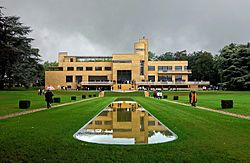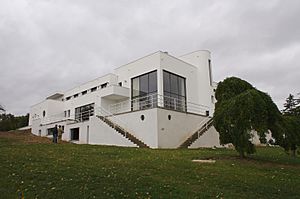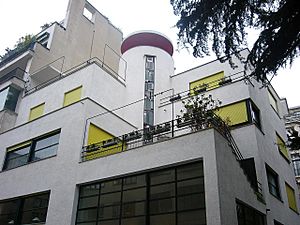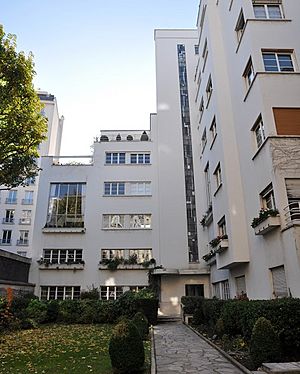Robert Mallet-Stevens facts for kids
Quick facts for kids
Robert Mallet-Stevens
|
|
|---|---|

Villa Cavrois
|
|
| Born | March 24, 1886 Paris, France
|
| Died | February 8, 1945 Paris, France
|
| Occupation | Architect |
| Buildings | Villa Cavrois Villa Noailles |

Robert Mallet-Stevens (born March 24, 1886 – died February 8, 1945) was a famous French architect and designer. He is known for his modern and unique building styles. His work often featured straight lines and simple shapes. He helped shape the look of modern architecture in the 20th century.
Contents
Who Was Robert Mallet-Stevens?
Robert Mallet-Stevens was born in Paris, France. His family had a strong connection to art. His father and grandfather were art collectors. His great-uncles were well-known Belgian painters. This artistic background likely influenced his own creative path. He studied architecture at a special school in Paris. During his studies, he wrote about how different art forms connect.
What Did He Do in His Career?
Mallet-Stevens was very active in the art and design world. In 1924, he started a magazine called La Gazette Des 7 Arts. At the same time, he helped create a club for friends of the "7th art," which refers to cinema. He was one of the first architects to be very interested in movies. He even designed film sets for silent films. His work for the movie L'Inhumaine (1924) is considered a masterpiece.
He designed many different types of buildings. These included shops, factories, and apartment buildings. He also designed private homes and their interiors. In the 1920s, he built an entire street in Paris, Rue Mallet-Stevens. This street has six houses that he designed himself.
In 1922, he published a collection of 32 of his designs. It was called Une Cité Moderne, meaning "A Modern City."
How Did He Work With Others?
Robert Mallet-Stevens was a great team player. He brought together many talented artists and craftspeople. These included interior designers, sculptors, and lighting experts. They all worked together on his projects.
He also helped form the Union des Artistes Moderne (UAM) in 1929. This group was made up of 25 designers who wanted to explore new ideas in art and design. Robert was the leader of this important group.
Important Buildings and Projects
Robert Mallet-Stevens designed many famous buildings. Here are some of his most well-known works:
- Villa Paul Poiret (1921–1923), located in Mézy-sur-Seine.
- Villa Noailles (1923–1928), found in Hyères.
- Villa Cavrois (1929–1932), located in Croix.
- The houses on Rue Mallet-Stevens (1927) in Paris, including:
- Villa Allatini
- Villa de Daniel Dreyfuss
- Villa Reifenberg
- Villa des Frères Martel
- Villa Mallet-Stevens
- A fire station (Caserne des Pompiers) built in 1935 in Paris.
- An apartment building (Immeuble de rapport) on rue Méchain in Paris (1928-1929).
His Legacy and Impact
After Robert Mallet-Stevens passed away, his work was not widely known for some time. This was because he had asked for his personal papers and designs to be destroyed. However, in 2005, a special exhibit in Paris brought his work back into the public eye. This show featured his drawings, models, and actual works. It helped people rediscover his important contributions to modern architecture. Today, he is recognized as a key figure in the history of design.
See also
 In Spanish: Robert Mallet-Stevens para niños
In Spanish: Robert Mallet-Stevens para niños




